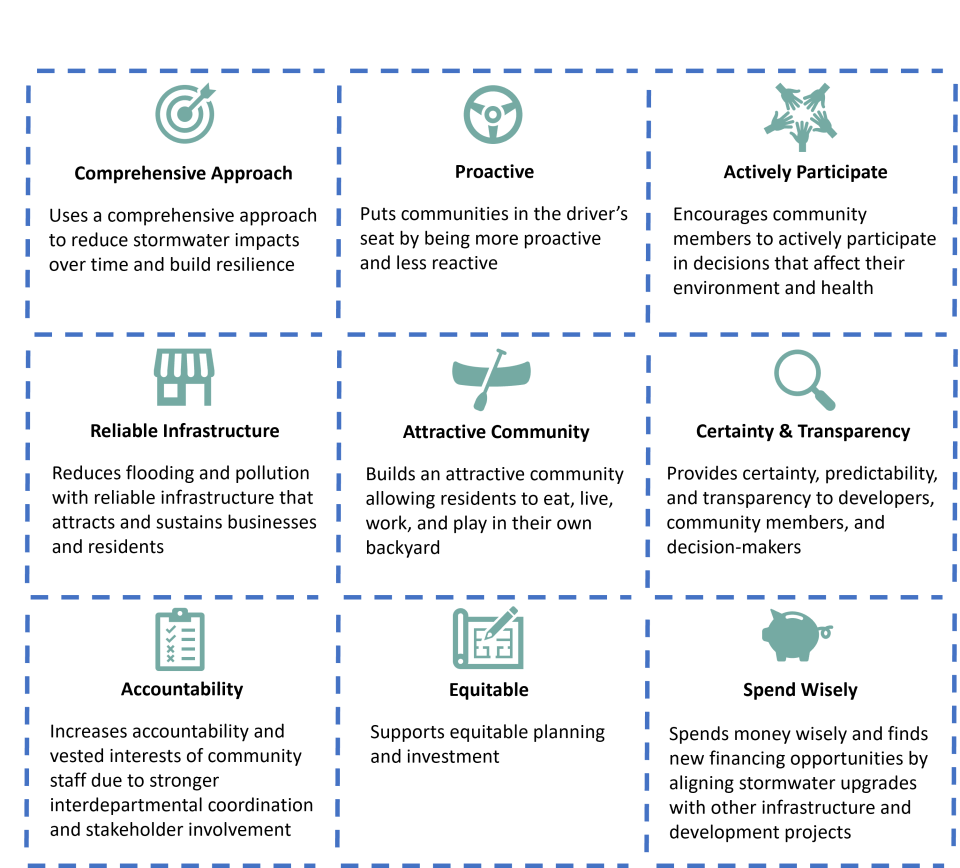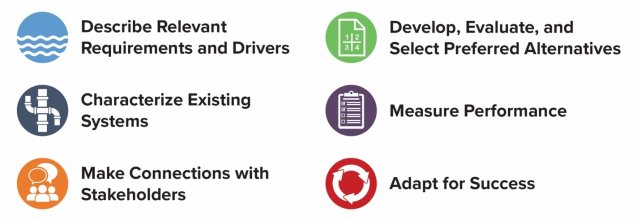About Stormwater Planning
Background
Long-term stormwater planning follows the six elements of the Integrated Planning Framework. It involves assessing a community’s water quality, human health, and other drivers of decision-making and investment. It also involves setting goals, analyzing opportunities, and implementing improvements over a long period of time. Using a proactive planning approach to manage stormwater can help communities maximize benefits while addressing regulatory obligations and aging infrastructure.
Long-term stormwater planning does not remove obligations to comply with the Clean Water Act, change existing regulatory standards, or modify permitting requirements. However, regulated communities with coverage under a municipal separate storm sewer system (MS4) permit can use long-term stormwater planning to help meet specific permit requirements and be more strategic about implementation approaches and timelines. Communities with unregulated stormwater systems may also benefit from developing these plans to make proactive infrastructure decisions.
Some communities may find it useful to develop a standalone, written, long-term stormwater plan. Others may prefer to embed their long-term stormwater planning goals and strategies into other community plans. By planning for the future, communities can document issues and solutions in a comprehensive way and better position themselves to compete for funding.

Benefits

Approach and Materials to Get Started
Successful long-term stormwater planning involves assessing your community’s drivers, setting goals, analyzing opportunities, and then implementing those opportunities to make improvements. This process emphasizes and relies upon obtaining stakeholder input and involvement from community members who are most impacted by stormwater.
Long-Term Stormwater Planning Guide
Long-Term Stormwater Planning: A Voluntary Guide for Communities (pdf) lays out a voluntary process that any community can use to apply a long-term planning approach to stormwater management as a part of an Integrated Planning approach or as a standalone effort. The information developed through this process can be incorporated into an integrated plan. Each section in this guide outlines steps, tips, and resources that communities can use to follow a long-term stormwater planning process:

Worksheets
Communities working through the long-term stormwater planning process outlined in the Long-Term Stormwater Planning: A Voluntary Guide for Communities (pdf) may reference a series of downloadable worksheets with questions and prompts to help document their process and decisions. The worksheets are intended to be an easy-to-use tool that a community can reference; populate; expand upon; and even incorporate directly into an integrated plan, long-term stormwater plan, or other community plan. Each community can tailor the long-term stormwater planning process and structure the resulting plans in a way that best suits its needs.

- Worksheet 1: Identify Stakeholders (docx)
- Worksheet 2: Identify Drivers and Issues (docx)
- Worksheet 3: Identify Goals (docx)

- Worksheet 4: Mapping and Data Management (docx)
- Worksheet 5: Asset Conditions (docx)
- Worksheet 6: Capital Improvements (docx)


- Worksheet 7: Strategy Implementation Summary (docx)
- Worksheet 8: Strategy Prioritization (docx)
- Worksheet 9: Financial Needs (docx)


